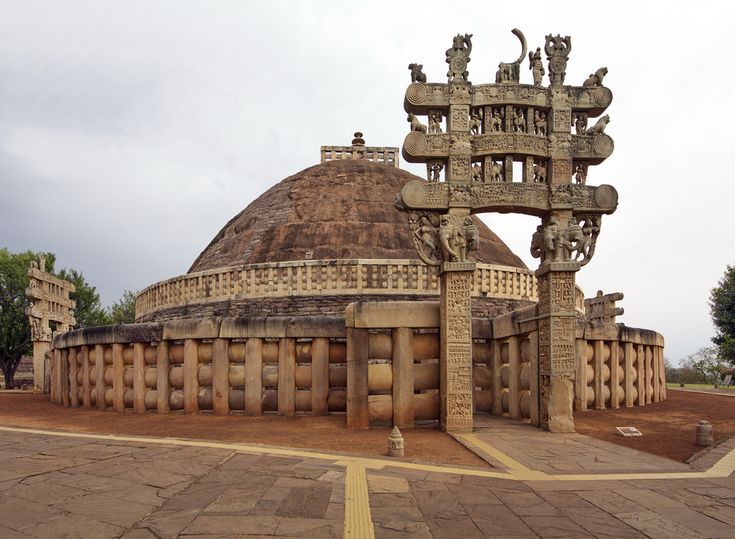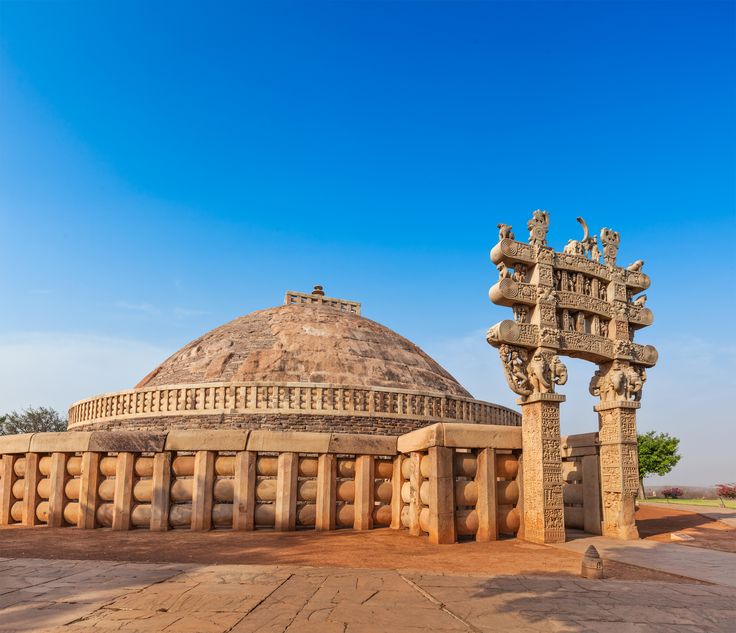Exploring the Historical Places Of Madhya Pradesh , Sanchi Stupa.

Introduction
Madhya Pradesh, often referred to as the “Heart of India,” is renowned for its rich historical and cultural significance. This state is a treasure trove of architectural marvels, ancient temples, and historic monuments that bear testimony to India’s rich heritage. Among these, the Sanchi Stupa stands out as one of the most iconic symbols of the state’s past. Situated in the small town of Sanchi, this UNESCO World Heritage site is a beacon of India’s Buddhist heritage and draws tourists from all over the world. The grand Sanchi Stupa is not only an architectural marvel but also a spiritual center for Buddhist teachings.
History of Sanchi Stupa
Buddhist Connection
Sanchi Stupa’s deep-rooted connection with Buddhism dates back to the 3rd century BCE when it was originally commissioned by Emperor Ashoka. The Emperor, after his conversion to Buddhism, took it upon himself to spread the teachings of Buddha across his empire. Sanchi, with its strategic location near the ancient trade routes, became a significant center for Buddhist culture and religious activities. The Great Stupa, also known as Stupa No. 1, was built as a dome-like structure to house the relics of Buddha.
Architectural Evolution
The original structure of Sanchi Stupa was quite simple, but over the centuries, it underwent several modifications and enhancements. Initially built with bricks and mud, it was later enlarged and encased with stone slabs. In the 1st century BCE, the four exquisitely carved gateways, or Toranas, were added, transforming the Stupa into a magnificent architectural monument.
Role of Emperor Ashoka
Emperor Ashoka played a crucial role in the development of Sanchi as a prominent Buddhist site. His dedication to the spread of Buddhist teachings led to the construction of numerous stupas and monasteries in the region. The Sanchi complex also includes Ashoka’s Pillar, which is inscribed with edicts that promote moral teachings and non-violence, reflecting Ashoka’s vision of a harmonious society.
Architectural Marvel of Sanchi Stupa
The Main Stupa (Stupa No. 1)
The Sanchi Stupa is a hemispherical structure symbolizing the Wheel of Dharma, a core tenet of Buddhist philosophy. The large dome stands as a representation of the mound of dirt under which Buddha’s relics were buried, and the central pillar inside signifies the axis mundi, a cosmic axis connecting the heavens and earth. This central element symbolizes the attainment of Nirvana, a state of liberation from the cycle of rebirth.
Toranas (Gateways)
The four Toranas, located at the four cardinal points of the Stupa, are artistic masterpieces. These gateways are adorned with intricate carvings that depict significant scenes from Buddha’s life, his birth, enlightenment, first sermon, and the many Jataka tales, which illustrate moral lessons. Each Torana represents an aspect of Buddha’s life, making them significant not just architecturally but also spiritually.
Surrounding Structures
The Sanchi complex is not limited to the main stupa. It also includes other stupas, monasteries, temples, and a series of pillars. Stupas No. 2 and 3, although smaller, are historically important, housing relics of Buddha’s disciples. The monastery ruins scattered around the complex offer a glimpse into the monastic life that once thrived here. The presence of smaller votive stupas around the main stupa reflects the devotion of pilgrims who came to Sanchi over the centuries.

Significance of Sanchi Stupa
Spiritual Importance
Sanchi Stupa has always served as a center for meditation and spiritual practice. Monks would gather here to reflect on the teachings of Buddha and seek inner peace. The serene environment of the complex enhances its spiritual aura, attracting both Buddhists and non-Buddhists alike who seek calm and introspection.
Cultural and Historical Importance
The stupas and inscriptions found at Sanchi provide invaluable insights into the evolution of Buddhist art and history. The relief carvings on the Toranas, for instance, are some of the finest examples of ancient Indian art. These depictions are not just religious but also offer historical narratives, recording the social and political life of that era.
UNESCO World Heritage Site
In 1989, Sanchi Stupa was declared a UNESCO World Heritage site, recognizing its cultural significance on a global scale. The monument stands as an example of how Buddhism shaped ancient Indian architecture and culture, influencing art forms that spread across Asia.
Tourist Experience at Sanchi Stupa
Exploring the Site
A visit to Sanchi Stupa is a walk through history. The main stupa, with its grand gateways and serene ambiance, is the primary attraction. However, tourists should not miss the smaller stupas, the Ashoka Pillar, and the remains of the ancient monasteries. Each corner of the site has a story to tell.
Sanchi Museum
Located near the Stupa complex, the Sanchi Museum is a must-visit for anyone interested in ancient artifacts. It houses a remarkable collection of sculptures, relics, and other Buddhist artifacts, giving visitors a deeper understanding of the artistic and religious significance of Sanchi.
Nearby Attractions
Sanchi’s location makes it a convenient base for exploring other historical sites. The Udayagiri Caves, known for their Gupta-era rock-cut sculptures, are just a short drive away. Vidisha, an ancient city, and the Heliodorus Pillar, erected by a Greek ambassador, are also close by, adding to the historical richness of the area.
Best Time to Visit and Accessibility
When to Visit
The best time to visit Sanchi is between October and March when the weather is pleasant and ideal for exploring the open-air complex. The winter months provide relief from the scorching summer heat, making it more comfortable to roam around the vast site.
How to Reach
Sanchi is well-connected to major cities. The nearest airport is in Bhopal, located around 55 kilometers away. From Bhopal, one can easily reach Sanchi by road or train. Sanchi Railway Station is well-connected, and buses and taxis are available for local transport.
Local Facilities
Visitors will find basic accommodations and eateries in Sanchi, while Bhopal offers more comfortable options. There are also tourist information centers and local guides available to provide insights into the history and significance of the complex.

Sanchi Stupa and Modern Day Tourism
Cultural Events
While Sanchi is primarily a historical and spiritual site, cultural festivals and Buddhist celebrations are occasionally held, adding vibrancy to the otherwise peaceful environment. Such events allow tourists to witness traditional performances and rituals that have been practiced for centuries.
Photography and Sightseeing
Sanchi Stupa is a photographer’s paradise. The detailed carvings on the gateways, the symmetry of the Stupa, and the picturesque surroundings make for incredible photo opportunities. Visitors with a keen interest in history and architecture will find plenty to admire and capture.
Impact on Local Economy
Sanchi Stupa plays a vital role in the local economy, attracting both domestic and international tourists. The influx of visitors boosts local businesses, including hotels, restaurants, and souvenir shops. Tourism here also provides employment opportunities for locals as guides, drivers, and artisans.
Conclusion
Sanchi Stupa is not just a monument; it’s a living piece of history that has withstood the test of time. Its spiritual, cultural, and architectural significance makes it a must-visit destination for anyone interested in India’s rich heritage. Whether you’re a history buff, an art enthusiast, or a spiritual seeker, Sanchi Stupa offers an enriching experience that will leave a lasting impression.
FAQ
1. What is the significance of the Sanchi Stupa?
The Sanchi Stupa is significant as one of the oldest stone structures in India and a symbol of Buddhist art and culture. It houses relics of Buddha and is a UNESCO World Heritage site.
2. When was the Sanchi Stupa built?
The Sanchi Stupa was commissioned by Emperor Ashoka in the 3rd century BCE.
3. How can I reach Sanchi?
Sanchi is easily accessible by road and rail. The nearest airport is in Bhopal, about 55 km away, and Sanchi Railway Station is well-connected.
4. What can I see at the Sanchi complex?
Visitors can explore the main Stupa, the Toranas (gateways), smaller stupas, monasteries, the Ashoka Pillar, and the Sanchi Museum.
5. What is the best time to visit Sanchi?
The ideal time to visit Sanchi is between October and March when the weather is cooler and more pleasant.
